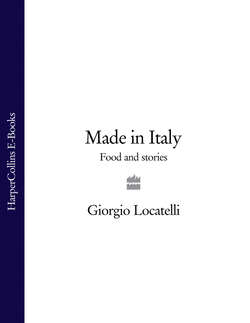Читать книгу Made in Italy: Food and Stories - Giorgio Locatelli - Страница 5
La Convivialità
ОглавлениеI wanted to call this book Made of Italy, because that is what I am – but I could as easily have called it La Convivialità – because that is the word I use most to explain the way Italians feel about food. For us the sign of welcome is to feed people. At the heart of all cooking, whether you are rich or poor, is the spirit of conviviality, the pleasure that comes from sharing a meal with others. And there is no enjoyment of food, without quality.
The way I think about food is entirely in tune with the Slow Food movement, started in Italy back in 1986 by Carlo Petrini in defiance of the opening of a McDonalds outlet in the Piazza di Spagna in Roma. Now a world wide force, Slow Food champions local, traditional produce with real flavour, made by caring people with skill and wisdom, which is celebrated every two years – with wonderful conviviality – at the Salone del Gusto, the famous food fair in Torino.
In the UK it is easy to blame supermarkets for clocking up air miles, for persuading us that we want fruit and vegetables that look perfect, but often have little flavour; for luring us on to diets of things that are salty, fatty, sugary and easy to eat; for packaging everything into convenient parcels so that we almost forget where our food comes from; and conditioning us to think that as long as our food is cheap, we are satisfied. But we have responsibilities too, and we have the power to change things. Of course I understand when you have kids you want to go to the supermarket, not traipse for miles trying to find a good butcher and fishmonger and green-grocer, and I’m not sitting here in my restaurant saying, you must do this and that, only remember that every time you pick up food in a supermarket, you are making a choice that has consequences. Where do you want to invest your money? In the profits of a supermarket, or in a farm rearing fantastic old breeds of pigs, or a small dairy making beautiful cheese?
You will see the letters DOP (PDO in the UK) and IGP (PGI in the UK) throughout the book. DOP represents Denominazione di Origine Protetta or Protected Designation of Origin (PDO), and it appears alongside the specific name of a product such as Parmigiano Reggiano or prosciutto di Parma. What it tells you is that in order to earn the stamp of the DOP and be allowed to use this name, the food must be produced in a designated area, using particular methods. IGP represents Indicazione Geografica Protetta, or Protected Geographical Indication (PGI), which is similar, but states that at least one stage of production must occur in the traditional region, and doesn’t place as much emphasis on the method of production. Whenever you buy Italian produce, look out for these symbols.
Salt should ideally be natural sea salt, and pepper freshly ground and black. Spend a little extra on good extra virgin olive oil and vinegar, and it will repay you a thousand times. And whenever possible buy whole chickens, and meat and fish on the bone, not portioned and wrapped in plastic.
All recipes serve 4, unless otherwise stated
